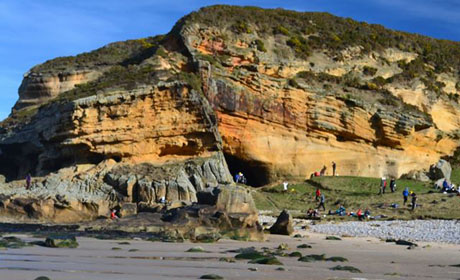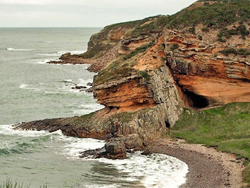Clashach
Moray, Scotland

Porous sandstones provide important oil and gas reservoirs in the subsurface. However, the porosity and permeability structure can become strongly modified by faulting, making the development of oil fields far more difficult, and costly.
Outcrops, especially from Utah, have shown that larger faults are commonly surrounded by a halo of structural damage represented by micro-faults, called deformation bands, so that the degradation of reservoirs can exist significantly beyond an particular fault.

The best place in Britain, and of direct relevance to the North Sea, to see faults in sandstones and their associated arrays of deformation bands lies along the southern shore of the Moray Firth near Lossiemouth.
Here the Hopeman Sandstone (Permo-Triassic), a formation of sand dunes, is an excellent unit for showing students what a conventional hydrocarbon reservoir looks like. It is equivalent to the Rotliegend gas reservoirs of the southern North Sea. And it contains faults.
The best of these lies in Clashach Cove. The fault has a throw of c 25m. This provides an amphitheatre with the Clachach Fault running across the mouth of the cover. The two retaining walls provide excellent transects into the fault zone, supplemented by small outcrops of the fault core in the beach, depending on the state of the sand.
The fault core, intense arrays of anastamosing deformation bands, is about 1m wide. Outside this zone the surrounding wall rocks contain sparse deformation bands that apparent decrease in number away from the main fault.
Text: Professor Rob Butler